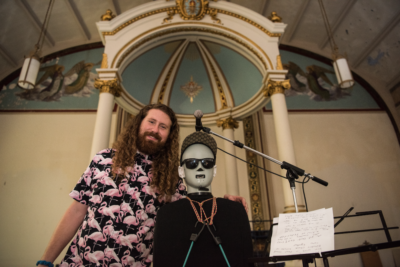3D Sound: How to Make a Record Using a Binaural Head [With Video]
3D sound recording and mixing is seeing a fast expansion. There’s a plethora of plugins—more every day—that will help audio engineers to place ambisonic audio all over the place working in the box (ITB). But there are other classic techniques available for creating immersive effects.
In this world premiere video from Chesky Records, the time-honored practice of binaural recording—commonly accomplished by using a single two-eared “dummy head” microphone to capture a 3D sound field—is clearly demonstrated.
Centered around an inventively soulful performance by bassist and vocalist Casey Abrams, the song “Robot Lovers” is the lead single from his upcoming Chesky Records album debuting in Spring 2018.
We talked to Chesky engineer Nicholas Prout about the techniques that went into recording this single, which launches Friday, November 10th on iTunes, Spotify, Amazon, and HDtracks. (To help promote interest in the format, the label is offering SonicScoop readers 25% off any release at HDtracks. Just use the code ROBOTSCOOP at checkout.)
It Happens in Real Time
Recorded at the Hirsch Center in Greenpoint, Brooklyn, Abrams’ single is the latest in the Chesky “Binaural+” Series, which presents the listener with spacious, lush and multi-dimensional 3D sound experiences.
“The video for ‘Robot Lovers’ shows how we make a binaural recording,” engineer Nicholas Prout told me. “The position of each player and their distance from the mic is critical as they cannot be changed in post production.
“The dummy head records the whole space that it is in and everything about the sounds around it,” Prout continues. “When we explained this to Jacob Scesney, the saxophone player in Casey’s band, he saw it as an opportunity to add his own special effects by moving 360 degrees around the microphone when soloing on this and one other song — one of the more imaginative uses of the technology.”
Viewers will notice a microphone in front of the dummy head, but this mic is not part of the recording chain. Instead it goes to a PA system in the space, in pursuit of its own effect.
“When a singer gets close to the dummy head the sound is very dry,” explains Prout.
“So we set the extra microphone—a Beyer m160—to keep the singer’s position consistent, and then send a little of the voice to the PA which is how we add reverb. The signal usually goes through a delay line which creates pre-delay. The delay time is usually 120ms-240ms depending on the song.”
In the video, viewers will notice one shot of the room (around 2:05) that Chesky uses as the control room, where the feed from the dummy head is split between the main system and a backup system.
“The main recording chain is a Mytek Brooklyn A to D converter recording at 192kHz 24 bit through a SoundBlade interface to a hard drive,” Prout says.
“The backup system uses a Mytek A to D converter recorded to Logic. The backup system is the one we use for playback. We do not bring speakers to the sessions but have many pairs of headphones to choose from. [Label co-founder] David Chesky and I use Ultimate Ears in-ear monitors.”
The musicians in a Chesky binaural session usually don’t wear headphones while recording. (Click here for an in-depth interview with David Chesky on his approach to binaural recording). “Robot Lovers” is no exception. “The balance is set by the players,” notes Prout, “with the general rule being, ‘if you can’t hear the singer you’re playing too loud.’ Most musicians easily adapt to this system.
“For ‘Robot Lovers’ we did three takes which is average for this process. Sometimes we’ll record an insert of the ending or any other part of the song that may not have come out as good as it could be, but for this song three complete takes did the trick.
— David Weiss
Please note: When you buy products through links on this page, we may earn an affiliate commission.







